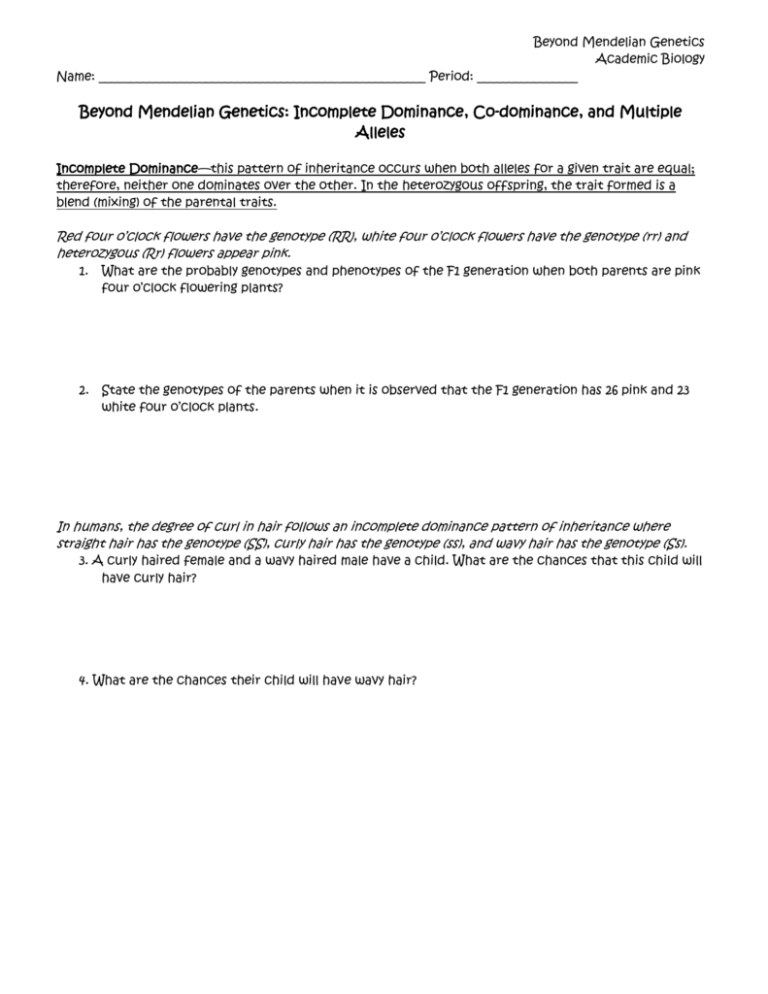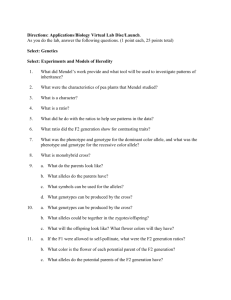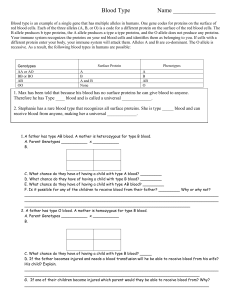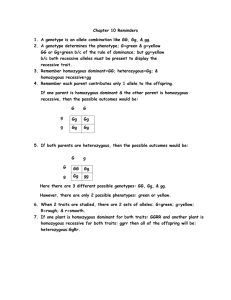Beyond Mendelian Genetics Academic Biology Name: Period
advertisement

Beyond Mendelian Genetics Academic Biology Name: ____________________________________________________ Period: ________________ Beyond Mendelian Genetics: Incomplete Dominance, Co-dominance, and Multiple Alleles Incomplete Dominance—this pattern of inheritance occurs when both alleles for a given trait are equal; therefore, neither one dominates over the other. In the heterozygous offspring, the trait formed is a blend (mixing) of the parental traits. Red four o’clock flowers have the genotype (RR), white four o’clock flowers have the genotype (rr) and heterozygous (Rr) flowers appear pink. 1. What are the probably genotypes and phenotypes of the F1 generation when both parents are pink four o’clock flowering plants? 2. State the genotypes of the parents when it is observed that the F1 generation has 26 pink and 23 white four o’clock plants. In humans, the degree of curl in hair follows an incomplete dominance pattern of inheritance where straight hair has the genotype (SS), curly hair has the genotype (ss), and wavy hair has the genotype (Ss). 3. A curly haired female and a wavy haired male have a child. What are the chances that this child will have curly hair? 4. What are the chances their child will have wavy hair? Co-Dominance-this pattern of inheritance occurs when there is more than one dominant allele for a single gene and both alleles are visible in the hybrid organism’s phenotype. Feather color in some chickens is co-dominant such that feather color can be represented as: black (CBCB), white (CWCW), and erminette (CBCW). Erminette chickens have a mixture of black feathers and white feathers. 5. A black chicken and an erminette chicken are crossed. What are the expected genotypic and phenotypic ratios from the cross? 6. Can two erminette chickens produce all three chicken color varieties? Explain using a Punnett square. 7. Two chickens were crossed and their resulting offspring were 50% white and 50% erminette. What are the most likely genotypes of the parents? In cows, coat color follows a co-dominance pattern of inheritance. 8. A homozygous red bull (CRCR) is mated with a homozygous white cow (CWCW). They offspring produced are roan in color (roan is a mixture of red and white hairs). Give the genotypes of the offspring. 9. In a different cross of cattle, offspring were produced in a 1:2:1 ratio. Give the genotypes and phenotypes of the parents. Multiple Alleles—some traits have more than 4 or more possible phenotypes and are coded for by more than two alleles. This means that the populations can have multiple alleles but each individual still only gets two. In humans, blood type exists as four possible phenotypes: A, B, AB, and O. There are three alleles for the A B gene that determines blood type as follows, where I and I are co-dominant to the allele that codes for blood type O. Allele A I B I O I Codes for: Type A blood Type B blood Type O blood This means that the corresponding genotypes and phenotypes are as follows: Genotypes AA I I AO I i BB I I BO I i AB I I OO i i Phenotypes Type A Type A Type B Type B Type AB Type O OO 10. Give the possible phenotypic blood types of the offspring when the father is type O blood (i i ) BB and the mother is type B blood (I I ). 11. What genotypic blood types must parents have in order to produce offspring of blood types A and O? 12. What genotypes must parents have in order to produce four different phenotypic blood types? 13. To produce a family of blood type A and AB, give the genotypes of the parents. 14. What are the possible blood types of a child whose parents are both heterozygous for type B blood? 15. Jill has type O blood. She has two older brothers with blood types A and B. What are the genotypes of her parents? In rabbits, multiple (four different) alleles determine fur color: C=agouti color, ch=chinchilla color, h=Himalayan color, a=albino. The C allele is dominant over all other alleles. The ch allele is dominant to the h allele and to the a allele. The h allele is dominant to the a allele. A rabbit with the genotype C a is crossed to a rabbit of the genotype ch h. 16. What are the genotypic and phenotypic ratios of their offspring? An agouti rabbit is crossed with an albino rabbit and they have 6 bunnies. Two of the bunnies are Himalayan in color. 17. What are the genotypes of the parents? 18. What other color possibilities exist for their offspring? Polygenic Inheritance – this inheritance occurs when a trait in controlled by two or more genes on different chromosomes. In Labrador Retriever dogs, coat color is determined by two genes for pigment: melanin production (B for black is dominant to b for chocolate) and melanin deposition (E for deposition is dominant to e for no deposition). Yellow labs may be homozygous dominant, homozygous recessive, or heterozygous for pigment production but are homozygous recessive for melanin deposition. Chocolate labs are homozygous recessive for melanin production but may be homozygous dominant or heterozygous for melanin deposition. Black labs may be homozygous dominant or heterozygous for melanin production and for melanin deposition. 16. Write all the possible genotypes for yellow, chocolate, and black labs. 17. Male and female chocolate labs were mated and had a litter of 12 puppies. Eight of the puppies were yellow. What were the genotypes of the parents? 18. How many of the other puppies were chocolate and how many were black? Explain your reasoning. 19. Could two black labs parent a litter of puppies made up of all three colors? Explain your reasoning.









